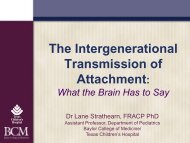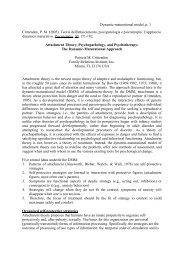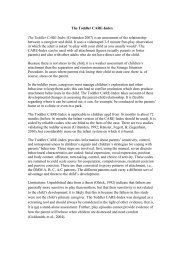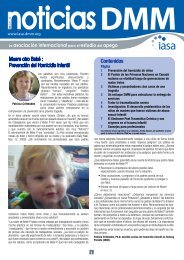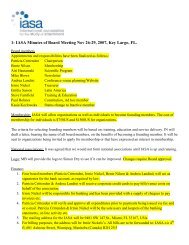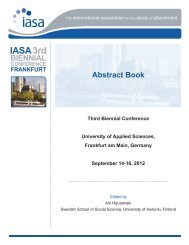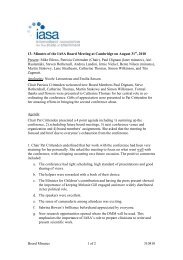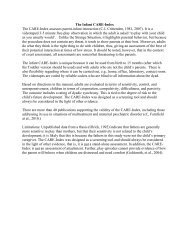Attachment, Personality Disorder And Its Psychological ... - IASA
Attachment, Personality Disorder And Its Psychological ... - IASA
Attachment, Personality Disorder And Its Psychological ... - IASA
Create successful ePaper yourself
Turn your PDF publications into a flip-book with our unique Google optimized e-Paper software.
<strong>Attachment</strong>, <strong>Personality</strong><br />
<strong>Disorder</strong> and <strong>Its</strong><br />
<strong>Psychological</strong> Treatment<br />
Peter Fonagy PhD FBA<br />
University College London<br />
& the Anna Freud Centre<br />
P.Fonagy@UCL.AC.UK<br />
1
Acknowledgments<br />
• UCL/AFC<br />
‣ Prof George Gergely<br />
‣ Dr Pasco Fearon<br />
‣ Dr Mary Target<br />
‣ Prof Anthony Bateman<br />
• Department of Psychology University of Leuven<br />
‣ Dr Patrick Luyten<br />
2
Acknowledgments<br />
• Menninger Clinic/Baylor Medical College<br />
‣ Dr Jon Allen<br />
‣ Dr Carla Sharp<br />
‣ Dr Lane Strathearn<br />
‣ Dr Efrain Bleiberg<br />
‣ Dr Brooks King-Casas<br />
‣ Dr Read Montague<br />
• Yale Child Study Centre<br />
‣ Prof Linda Mayes<br />
<strong>And</strong> Dr Liz Allison, Rose Palmer and Fran Fonagy for help with the preparation of this presentation.<br />
3
Sroufe and colleagues (Sroufe et al., 2005)<br />
conclude “nothing is more important in<br />
children’s development than how they are<br />
treated by their parents, beginning in the<br />
early years of life” (p. 288).<br />
4
Coan (2008) “One of the striking things about<br />
humans (and many other mammals) is how well<br />
designed we are for affiliation” (p. 247)… “the<br />
brain’s first and most powerful approach to affect<br />
regulation is via social proximity and interaction.<br />
This is most obvious in infancy….. (p. 255)<br />
Coan (2008) “One of the striking things about humans (and many other<br />
mammals) is how well designed we are for affiliation” (p. 247, emphasis in<br />
original). More specifically, the attachment system is “primarily concerned with<br />
the social regulation of emotion responding” (p. 251).<br />
the brain’s first and most powerful approach to affect regulation is via<br />
social proximity and interaction. This is most obvious in infancy….<br />
Because the PFC [prefrontal cortex] is underdeveloped in infancy, the<br />
caregiver effectively serves as a kind of ‘surrogate PFC’—a function<br />
that attachment figures probably continue to serve for each other to<br />
varying degrees throughout life. (p. 255)<br />
social affect regulation is a relatively effortless, “bottom-up” process that<br />
ameliorates the initial perception of threat and thus decreases the need<br />
for effortful distress regulation.<br />
In contrast, self-regulating by a relatively “top-down” process involves<br />
more effortful control over attention and cognition (i.e., explicit<br />
mentalizing), relying to a greater degree on the prefrontal cortex. He<br />
concludes,<br />
“Simply put, affect regulation is possible, but more difficult, in isolation”<br />
(Coan, 2008, p. 256).
Clinical Features of Borderline <strong>Personality</strong><br />
<strong>Disorder</strong> (DSM-IV: 5 of 9)<br />
• a pattern of unstable intense relationships,<br />
• inappropriate, unstable intense relationships<br />
anger<br />
• frantic efforts to avoid abandonment<br />
• affective affective instability, dysregulation<br />
• impulsive actions<br />
impulsivity<br />
• recurrent self-harm & suicidality,<br />
• chronic feelings aggression<br />
of emptiness or boredom<br />
(dysphoria),<br />
• transient, stress-related paranoid thoughts<br />
• identity disturbance severe dissociative<br />
symptoms
Is <strong>Personality</strong> Not Just Genetics Anyway<br />
• Studies of psychiatric patients show BPD is<br />
familial<br />
‣ White CN, Gunderson JG, Zanarini MC, Hudson JI. Family studies of borderline<br />
personality disorder: A review. Harvard Review of Psychiatry 2003;11(1):8-19.<br />
‣ Zanarini MC, Barison LK, Frankenburg FR, Reich DB, Hudson JI. Family history<br />
study of the familial coaggregation of borderline personality disorder with Axis I and<br />
non-borderline dramatic cluster Axis II disorders. Journal of <strong>Personality</strong> <strong>Disorder</strong>s<br />
2009;23(4):357-369.<br />
• Studies of twin samples show it is heritable.<br />
‣ Bornovalova MA, Hicks BM, Iacono WG, McGue M. Stability, change, and<br />
heritability of borderline personality disorder traits from adolescence to adulthood: A<br />
longitudinal twin study. Development and Psychopathology 2009;21(4):1335-<br />
1353.<br />
‣ Distel MA, Trull TJ, Derom CA, et al. Heritability of borderline personality disorder<br />
features is similar across three countries. <strong>Psychological</strong> Medicine<br />
2008;38(9):1219-1229.<br />
‣ Kendler KS, Aggen SH, Czajkowski N, et al. The Structure of Genetic and<br />
Environmental Risk Factors for DSM-IV <strong>Personality</strong> <strong>Disorder</strong>s A Multivariate Twin<br />
Study. Archives of General Psychiatry 2008;65(12):1438-1446.<br />
‣ Torgersen S, Lygren S, Oien PA, et al. A twin study of personality disorders.<br />
Comprehensive Psychiatry 2000;41(6):416-425.<br />
‣ Torgersen S, Czajkowski N, Jacobson K, et al. Dimensional representations of DSM-<br />
IV cluster B personality disorders in a population-based sample of Norwegian twins:<br />
a multivariate study. <strong>Psychological</strong> Medicine 2008;38(11):1617-1625.<br />
-Non twin family studies increased rates of BPD in family members of BPD<br />
patients<br />
-Classical twin studies heritability estimates of around 40%<br />
-Adding siblings, spouses and parents of twins
But do we not know that bad things<br />
happen in the lives of these patients<br />
• Retrospective studies link harsh treatment<br />
early in life with later BPD.<br />
‣ Battle CL, Shea MT, Johnson DM, et al. Childhood maltreatment<br />
associated with adult personality disorders: Findings from the collaborative<br />
longitudinal personality disorders study. Journal of <strong>Personality</strong><br />
<strong>Disorder</strong>s 2004;18(2):193-211.<br />
‣ Zanarini MC. Childhood experiences associated with the development of<br />
borderline personality disorder. Psychiatric Clinics of North America<br />
2000;23(1):89-+.<br />
• Largely confirmed by prospective studies<br />
‣ Johnson JG, Cohen P, Chen HN, Kasen S, Brook JS. Parenting behaviors<br />
associated with risk for offspring personality disorder during adulthood.<br />
Archives of General Psychiatry 2006;63(5):579-587.<br />
‣ Carlson EA, Egeland B, Sroufe LA. A prospective investigation of the<br />
development of borderline personality symptoms. Development and<br />
Psychopathology 2009;21(4):1311-1334.<br />
‣ Crawford TN, Cohen PR, Chen HNA, Anglin DM, Ehrensaft M. Early<br />
maternal separation and the trajectory of borderline personality disorder<br />
symptoms. Development and Psychopathology 2009;21(3):1013-1030.
BPD and childhood maltreatment:<br />
recent prospective studies<br />
• Johnson and colleagues (Johnson et al., 2006)<br />
assessments of family members and their offspring<br />
spanning age 6 to 33<br />
‣ low levels of parental affection and nurturing<br />
‣ aversive parental behaviors such as harsh punishment<br />
‣ BUT: not specific to BPD<br />
• Lyons-Ruth and colleagues (Lyons-Ruth, Yellin,<br />
Melnick, & Atwood, 2005; Melnick et al., 2008)<br />
‣ disrupted maternal communication in infancy predicts<br />
symptoms of borderline pathology assessed at age 18<br />
‣ total amount of abuse over the lifetime reported in adolescence<br />
also contributes<br />
‣ disrupted maternal communication and later abuse make<br />
independent and additive contributions to pathology<br />
associated with borderline personality disorder.<br />
9
Early maternal separation and trajectory of<br />
borderline personality disorder symptoms<br />
Crawford et al. 2010<br />
Dev. & Psychopath.
BPD and Minnesota longitudinal study<br />
(Carlson, Egeland, & Sroufe, 2009)<br />
• Correlated extensive assessments from infancy<br />
onward with borderline personality disorder symptom<br />
at age 28<br />
• Early predictors borderline personality symptoms:<br />
‣ attachment disorganization .20*<br />
o (12-18 months),<br />
‣ maltreatment .20**<br />
o (12-18 months),<br />
‣ maternal hostility and boundary dissolution .42***<br />
o (42 months),<br />
‣ family disruption related to father presence .21**<br />
o (12-64 months),<br />
‣ family life stress .29***<br />
o (3-42 months).<br />
11
BPD and Minnesota longitudinal study<br />
(Carlson, Egeland, & Sroufe, 2009)<br />
• Early adolescent predictors (12 years)<br />
‣attentional disturbance,<br />
‣emotional instability,<br />
‣behavioral instability, and<br />
‣relational disturbance.<br />
• Disturbances in self-representation in early<br />
adolescence may mediate the link between<br />
attachment disorganization and personality<br />
disorder<br />
12
Mediating Role of Self-Representation<br />
(Carlson et al., 2009)<br />
Abuse<br />
Composite<br />
1.40** .09(1.04**)<br />
‣narrative projective tasks administered at age 12 that included<br />
‣intrusive violence related to the self,<br />
‣unresolved feelings of guilt or fear,<br />
‣bizarre images related to the self.<br />
<strong>Attachment</strong><br />
disorganization<br />
.08*<br />
Composite self-index<br />
1.04**<br />
Borderline symptoms<br />
Sobel Test: z=2.23, p
Diathesis-stress theories of BPD<br />
etiology<br />
• Theories suggesting an interaction between a<br />
child’s genetic vulnerability and adverse<br />
experiences in the family environment<br />
‣ Crowell SE, Beauchaine TP, McCauley E, Smith CJ, Stevens AL, Sylvers P.<br />
<strong>Psychological</strong>, autonomic, and serotonergic correlates of parasuicide among<br />
adolescent girls. Development and Psychopathology 2005;17(4):1105-1127.<br />
‣ Fonagy P, Target M, Gergely G. <strong>Attachment</strong> and borderline personality<br />
disorder - A theory and some evidence. Psychiatric Clinics of North<br />
America 2000;23(1):103-+.<br />
‣ Gunderson JG, Lyons-Ruth K. BPD'S interpersonal hypersensitivity<br />
phenotype: A gene-environment-developmental model. Journal of<br />
<strong>Personality</strong> <strong>Disorder</strong>s 2008;22(1):22-41.<br />
‣ Paris J. The development of impulsivity and suicidality in borderline personality<br />
disorder. Development and Psychopathology 2005;17(4):1091-1104.<br />
‣ Zanarini MC, Frankenburg FR. The essential nature of borderline<br />
psychopathology. Journal of <strong>Personality</strong> <strong>Disorder</strong>s 2007;21(5):518-535.
Diathesis-stress theories of BPD<br />
etiology<br />
•Need to directly evaluate the diathesisstress<br />
model by testing for interaction<br />
between inherited risk and harsh<br />
childhood treatment.<br />
‣Prospective longitudinal design with<br />
three things measured<br />
ofamilial liability<br />
oharsh treatment during childhood<br />
oearly-emerging symptoms of borderline<br />
personality soon thereafter.
A Test of Diathesis-Stress Theories of the<br />
Etiology of Borderline <strong>Personality</strong> <strong>Disorder</strong> in<br />
a Birth Cohort of 12 Year Old Children<br />
• Objective. To test if children with a positive family<br />
history of psychiatric disorder were more vulnerable to<br />
developing borderline personality symptoms following<br />
exposure to physical maltreatment and maternal<br />
negative expressed emotion.<br />
• Design. Prospective longitudinal cohort study of a<br />
nationally representative birth cohort in Great Britain.<br />
• Participants. 1,116 families with twins were followed<br />
from birth to age 12 years (retention 96%).<br />
• Main Outcome Measure. Dimensional borderline<br />
personality symptoms and dichotomous extreme<br />
borderline group membership (dimensional symptoms<br />
≥95th percentile).<br />
Belsky, Caspi, Arseneault, Bleidorn, Fonagy, Goodman, Houts, and Moffitt (submitted)<br />
16
Some possible attachment related<br />
components of the BPD<br />
phenomenological phenotype<br />
Affect Regulation<br />
Attention Control<br />
Disorganization<br />
of the Self<br />
BPD<br />
Mentalization
What is mentalizing<br />
Mentalizing is a form of imaginative<br />
mental activity about others or oneself,<br />
namely, perceiving and interpreting<br />
human behaviour in terms of<br />
intentional mental states (e.g. needs,<br />
desires, feelings, beliefs, goals,<br />
purposes, and reasons).<br />
18
What is mentalization<br />
• It is a capacity we use all the time<br />
• It is what we need:<br />
‣To collaborate<br />
‣To compete<br />
‣To understand feelings<br />
‣To teach<br />
‣To learn<br />
‣To know who we are<br />
‣To know that we are<br />
• Our awareness of mental states makes us<br />
laugh and cry<br />
It is a capacity we use all the time<br />
It is what we need TO EFFECTIVELY :<br />
To collaborate &<br />
To compete<br />
To teach &<br />
To learn<br />
To know who we are &<br />
To know that we are<br />
Our awareness of mental states makes us laugh and cry<br />
19
Forewarning – 1.<br />
In advocating mentalization-based treatment we<br />
claim no innovation. On the contrary,<br />
mentalization-based treatment is the least novel<br />
therapeutic approach imaginable: it addresses<br />
the bedrock human capacity to apprehend mind<br />
as such. Holding mind in mind is as ancient as<br />
human relatedness and self-awareness.<br />
—Allen & Fonagy (2006) Preface.<br />
Chichester: J. Wiley, 2006<br />
20
Mentalization and Overlapping Constructs<br />
(Choi-Kain & Gunderson, Am J Psychiat 2008)<br />
This Venn diagram maps the conceptual overlaps between<br />
mentalization<br />
and four related concepts including mindfulness, psychological<br />
mindedness, empathy, and affect consciousness, which are<br />
represented by the four circles. The lines which bifurcate the diagram<br />
according to its three dimensions (i.e., self-/other-oriented,<br />
implicit/explicit, and cognitive/affective) are dashed to illustrate the<br />
permeable and nonabsolute nature of these divisions. In the self/<br />
other dimension, mindfulness focuses more on mental states<br />
within oneself, while empathy is primarily understood in terms of<br />
one’s imagination of mental states within others. Both affect<br />
consciousness<br />
and psychological mindedness concern both sides of the<br />
self and other distinction. While mindfulness and psychological<br />
mindedness emphasize both cognitive and affective aspects of<br />
mental states and function explicitly, affect consciousness and empathy<br />
relate more primarily to affective mental contents and function<br />
both explicity and implicity. Mentalization lies at the intersection<br />
of these concepts but the boundaries between them are not<br />
distinctly drawn.<br />
21
Forewarning – 2.<br />
This product may contain traces of originality.<br />
These are only trace contaminants, occurring as<br />
part of the production process, and should not<br />
spoil your enjoyment of the product.<br />
22
Measuring Mentalization (Baron-Cohen et<br />
al., 2001) Reading the Mind in the Eyes Test<br />
Friendly - A<br />
Sad - B<br />
Surprised - C<br />
Worried - D<br />
23
Measuring Mentalization (Baron-Cohen et<br />
al., 2001) Reading the Mind in the Eyes Test<br />
Surprised-A<br />
Sure about something-B<br />
Joking-C<br />
Happy-D<br />
24
Measuring Mentalization (Baron-Cohen et<br />
al., 2001) Reading the Mind in the Eyes Test<br />
Joking-A<br />
Flustered-B<br />
Desire-C<br />
Convinced-D<br />
25
Mentalizing at the World Cup: How does Robert<br />
Green feel after letting in the USA goal<br />
Upset<br />
Angry<br />
Disappointed<br />
Frustrated<br />
Mentalization allows us to have common experiences – we need to<br />
coordinate our emotional experiences to function in large social groups.<br />
Imagine what would happen if we all felt differently about Lampard’s<br />
disallowed goal! Fortunately not the case.<br />
26
Have to be able to step into the shoes of another person -<br />
27
Shared neural circuits for mentalizing about the<br />
self and others (Lombardo et al., 2009; J. Cog. Neurosc.)<br />
Self mental state<br />
Other mental state<br />
Overlapping for<br />
Self and Other<br />
CAN DEVELOPMENTAL PSYCHOLOGUY RESEARCH HELP US<br />
GET CLOSER TO THE POTENTIAL SOCIAL EXPEREINCES THAT<br />
COULD SET OF THE EPIGENETIC CASCADE THAT Dr Moshe Szyf<br />
was describing to us yesterday<br />
INTERSUBJECTIVE ORIGINS OF THE SELF<br />
28
Relational Aspects of Mentalization<br />
• Overlap between neural locations of mentalizing<br />
self and other may be linked to intersubjective<br />
origin of sense of self<br />
‣ We find our mind initially in the minds of our parents<br />
and later other attachment figures thinking about us<br />
‣ The parent’s capacity to mirror effectively her child’s<br />
internal state is at the heart of affect regulation<br />
‣ Infant is dependent on contingent response of<br />
caregiver which in turn depends on her capacity to be<br />
reflective about her child as a psychological being<br />
JUST HOW IMPORTANT CONTINGENT RESPONDING TO AFFECT<br />
IS WE KNOW FROM STILL FACE PARADIGM (GERGELY)<br />
29
High congruent & marked mirroring<br />
Shows the infant ABSOLUTELY EXPECT TO FIND HIS MIND OUT<br />
THERE, IS IN NO SENSE PROVIDED WITH A MIND BY THE<br />
CAREGIVER BUT HE SEARCHES OUT, SEEKS OUT<br />
OPPORTUNITIES FOR SHARING OF SUBJECTIVITY BECAUSE OF<br />
EXTREMELY PWOERFUL BIOLOGICAL PREDISPOSITION. SO IN<br />
MIRRORING BUT MIRRORING MUST BE OF A SPECIAL KIND –<br />
NOT LIKE A REAL MIRROR
Mirroring must not be too accurate, it<br />
must be ‘marked’ (systematically<br />
distorted) so child knows he is not<br />
observing caregiver’s dispositional state<br />
Unmarked mirroring<br />
Marked mirroring<br />
Mirroring must not be too accurate, it must be ‘marked’ (systematically<br />
distorted) so child knows he is not observing<br />
IN SEVERAL STUDIES WITH Kos and Gergely WE HAVE SHOWN MARKED<br />
MIRRORING to LEAD TO MORE ROBUST MENTALIZATION
The Role of <strong>Attachment</strong> in Humans<br />
• Evolution uses the early attachment<br />
relationship as a signaling system to the<br />
newborn as to the kind of environment he/she<br />
might expect.<br />
‣An environment where caregivers do not have the<br />
time or resources to devote attention to the infant<br />
is far more likely to necessitate the later use of<br />
violence in order to ensure the survival of the<br />
individual in subsequent struggles for limited<br />
resources.<br />
‣Violence and mentalizing are not compatible
Security of attachment and mentalizing are<br />
intertwined in an intergenerational<br />
transmission process<br />
• For better<br />
‣parental security mentalizing capacity <br />
mentalizing interactions child security<br />
• For worse<br />
‣parental insecurity compromised<br />
mentalizing capacity non-mentalizingtraumatizing<br />
interactions child insecurity<br />
• The final link<br />
‣infant attachment security subsequent child<br />
mentalizing capacity<br />
33
Secure attachment is facilitative of<br />
mentalizing<br />
• Children pass theory of mind tasks earlier<br />
if<br />
‣Had secure attachment relations with parents<br />
in infancy<br />
‣If parent’s own state of mind in relation to<br />
attachment was secure<br />
‣Family members relate to each other in playful,<br />
mentalizing way<br />
• Mechanism may well be mediated by<br />
oxytocin<br />
Oxytocin is the VIAGRA of mentalization<br />
34
Oxytocin and performance on Mind in<br />
the Eyes test (Domes et al., 2008)<br />
Around in great quantity (breast feeding) when the infant needs it most<br />
– when it totally depends on being understood<br />
Oxytocin turns us towards the face to try to find the mind therein<br />
35
Gaze duration during oxytocin<br />
exposure<br />
BIOL PSYCHIATRY 2008;63:3–5<br />
Is there less oxyticin around when parents have insecure attachment history<br />
36
A provisional model of the<br />
developmental roots of mentalization<br />
Secure maternal attachment<br />
Increased maternal OXT while with infant<br />
More mentalizing (marked – contingent) response to<br />
infant distress<br />
Infant generates a 2 nd order representation of self state<br />
Improved affect regulation enhances interpersonal<br />
interactions<br />
Facilitative impact of social interaction on<br />
development of improved mentalization resilience
A provisional model of roots of<br />
disorganized mentalization<br />
Insecure disorganized maternal attachment<br />
Reduced maternal OXT while with infant<br />
Non-mentalizing (unmarked – non-contingent)<br />
response to infant distress undermines natural<br />
process for the maturation of mentalization<br />
Infant fails to internalize representation of self state<br />
Mentalizing goes awry (more frequently) particularly<br />
under conditions of high arousal and attachment<br />
activation: mental states are enacted<br />
Destructive impact on social interactions undermines<br />
further opportunities for social development of<br />
mentalizing vulnerability to trauma<br />
Need Oxy not to undermine natural process of the unfodling of<br />
mentalization (infants expect to find the contents of their mind) they look<br />
for it<br />
It has developmental roots in genetic or social or epigenetic diathesis<br />
that undermines the creation of robust social relationships that might<br />
help the child overcome an early deficit
Do patients with BPD have anything<br />
wrong with their mentalizing<br />
$20<br />
X 3<br />
healthy<br />
investor<br />
BPD<br />
trustee<br />
39
Average Repayment:<br />
repay everything<br />
repay investment (33%)<br />
repay nothing<br />
*King-Casas et al, in Science, 321,<br />
806-810<br />
40
60%<br />
50%<br />
Investor Sent<br />
MU sent / MU available<br />
44 non-psychiatric investors<br />
55 non-psychiatric investors<br />
40%<br />
30%<br />
20%<br />
10%<br />
1 2 3 4 5 6 7 8 9 10<br />
60%<br />
50%<br />
Trustee Repaid<br />
MU sent / MU available<br />
44 non-psychiatric trustees<br />
55 BPD trustees<br />
40%<br />
30%<br />
20%<br />
10%<br />
*King-Casas et al, in Science, 321, 806-810<br />
1 2 3 4 5 6 7 8 9 10<br />
rounds<br />
41
Specific to social‐decision making, not non‐social decision‐making<br />
Specific to BPD, not mood disorder<br />
Unoka, Seres, Aspán, Bódi, Kéri (2009)<br />
42
Do BPD patients have anything<br />
wrong with their mentalizing<br />
• Most likely to happen in in interpersonal<br />
context when they misunderstand and feel<br />
misunderstood by someone they care<br />
about<br />
• The non-mentalizing viscous cycle<br />
43
Cycles of inhibition of mentalizing<br />
Powerful emotion<br />
Frightening, undermining,<br />
frustrating, distressing or<br />
coercive interactions<br />
Poor mentalising<br />
Loss of certainty<br />
that thoughts are<br />
not real<br />
Try to control or<br />
change others<br />
Inability to understand<br />
or even pay attention<br />
to feelings of others<br />
Others seem<br />
incomprehensible
Vicious Cycles of Mentalizing Problems<br />
within a Relationship<br />
Powerful emotion<br />
Powerful emotion<br />
Frightening, undermining,<br />
frustrating, distressing or<br />
coercive interactions<br />
Poor mentalising<br />
Frightening, undermining,<br />
frustrating, distressing or<br />
coercive interactions<br />
Poor mentalising<br />
Person 1<br />
Inability to understand<br />
or even pay attention<br />
to feelings of others<br />
Person 2<br />
Inability to understand<br />
or even pay attention<br />
to feelings of others<br />
Try to control or<br />
change others or<br />
oneself<br />
Others seem<br />
incomprehensible<br />
Try to control or<br />
change others or<br />
oneself<br />
Others seem<br />
incomprehensible<br />
Powerful emotions in an interpersonal context activate the attachment system
Is there a human language which<br />
does not recognize love to be blind<br />
Common regions of deactivation<br />
with maternal and romantic love<br />
(Bartels & Zeki, 2008)<br />
Fig. 2. Deactivated regions with maternal and romantic love. The sections and<br />
rendered views show regions whose activity was suppressed with maternal<br />
love<br />
(cO vs. cA) (top). These regions were the same as those that were<br />
deactivated with romantic love (viewing loved partner vs. friends) in our<br />
previous study<br />
(bottom). All labelled regions reached significance at P < 0.05, corrected for<br />
small volume (for illustration, following thresholds were used—top: P < 0.05,<br />
uncorrected; bottom: P < 0.001, uncorrected). Abbreviations: A =<br />
amygdaloidal cortex, pc = posterior cingulate cortex, mp = medial<br />
prefrontal/paracingulate<br />
gyrus; mt = middle temporal cortex; op = occipitoparietal junction; tp =<br />
temporal pole.<br />
Two areas:<br />
•middle prefrontal, inferior parietal and middle temporal cortices mainly in the right hemisphere,<br />
as well as the posterior cingulate cortex attention, long-term memory, variable involvement in<br />
both positive negative emotions underpin interface of mood related cognition<br />
•amygdala, temporal poles, parietotemporal junction and mesial prefrontal cortex social<br />
trustworthiness, moral judgements, ‘theory of mind’ tasks, negative emotions, attentions<br />
BUT IS IT JUST AROUSAL OR IS IT SPECIFICT TO ATTACHMENT
The effect of attachment-related stress on the capacity to<br />
mentalize: Induction imagery scripts to participants (Nolte,<br />
Hudac, Mayes, Fonagy & Pelphrey, 2009)<br />
• Scripts obtained in a visit prior to scanning with the aim to<br />
create stress-related arousal states<br />
• Idiosyncratic content, personally meaningful<br />
• Common themes attachment stress: e.g. relationship<br />
breakup, funeral etc.<br />
• Common themes normal stress: e.g. exam preparation,<br />
lost objects etc.<br />
Scripts obtained in a visit prior to scanning with the aim to create stressrelated<br />
arousal states<br />
Idiosyncratic content, personally meaningful<br />
Common themes attachment stress: e.g. relationship breakup, funeral etc<br />
Common themes normal stress: e.g. exam preparation, lost objects etc.<br />
Edited, recorded, semi-standardized about 5 mins. of length each<br />
Only scripts that were subjectively rated 8 or above on a 1-10 scale of<br />
subjective stress accepted.<br />
No differences in subjective level of stress ratings between ‘attachment’ and<br />
‘normal’ stress<br />
47
The effect of attachment-related stress on the<br />
capacity to mentalize: Modified Reading Mind in Eyes<br />
Nolte, Hudac, Mayes, Fonagy & Pelphrey (2009)<br />
Stimuli<br />
Subjects were asked to make a judgment as fast<br />
and accurately as possible<br />
Which attitude<br />
Resentful<br />
Bored<br />
Which age<br />
Twenty-three<br />
Examples of single trial stimuli, RMET<br />
(top), control task (bottom).<br />
Thirty<br />
48
<strong>Attachment</strong> stress selectively disrupts mentalization<br />
performance<br />
Nolte, Hudac, Mayes, Fonagy & Pelphrey (2009)<br />
Accuracy scores<br />
Baseline/ post normal stress:<br />
p= 0.03<br />
Baseline/ post attachment stress:<br />
p=0.001<br />
Post normal/ post attachment stress:<br />
p=0.01<br />
stress<br />
<strong>Attachment</strong> stress disrupts RMET performance more than<br />
normal stress!<br />
49
Disruption in Mz performance associated with<br />
decreased activation of perspective taking<br />
regions<br />
0.8<br />
0.6<br />
0.4<br />
0.2<br />
0<br />
‐0.2<br />
‐0.4<br />
‐0.6<br />
L IFG<br />
No significant difference between<br />
runs.<br />
Baseline Neutral Attach<br />
Emotion<br />
Control<br />
0.8<br />
0.6<br />
0.4<br />
0.2<br />
0<br />
‐0.2<br />
‐0.4<br />
‐0.6<br />
L pSTS<br />
*<br />
Emotion<br />
Control<br />
Baseline Neutral Attach * p = 0.06<br />
0.5<br />
0.4<br />
0.3<br />
0.2<br />
0.1<br />
0<br />
‐0.1<br />
‐0.2<br />
‐0.3<br />
‐0.4<br />
L TPJ<br />
*<br />
Emotion<br />
Control<br />
Baseline Neutral Attach<br />
* p = 0.05<br />
Identified brain regions that show greater activation during the Reading the<br />
Mind in the Eyes Test (highlighted) and control task, see table. Below:<br />
Activation maps of the regions with greater activiaty during the REMT task.<br />
Left inferior frontal gyrus, posterior superior temporal sulcus and temporal<br />
parietal junction are areas that have repeatedly been associated with<br />
mentalization/ social cognition tasks (5), (6).<br />
50
<strong>Attachment</strong> Disorganisation in Trauma<br />
DISTRESS/FEAR<br />
Adverse<br />
Exposure<br />
Emotional<br />
to maltreatment<br />
Experience<br />
Activation of attachment<br />
Proximity seeking<br />
The ‘hyperactivation’ of the attachment system<br />
Hyperactivation of attachment system may be core aspect of BPD<br />
51
The hyper-reactivity of the<br />
attachment system in BPD<br />
• We assume that the attachment system in<br />
BPD is “hypersensitive” (triggered too<br />
readily)<br />
• Indications of attachment hyperactivity in core<br />
symptoms of BPD<br />
‣Frantic efforts to avoid abandonment<br />
‣Pattern of unstable and intense interpersonal<br />
relationships<br />
‣Rapidly escalating tempo moving from<br />
acquaintance to great intimacy<br />
52
Response to partner’s hypothetical<br />
cooperation in Assurances Game<br />
“Cooperate”<br />
2.5<br />
2<br />
1.5<br />
1<br />
Placebo<br />
Oxytocin<br />
0.5<br />
“Defect”<br />
0<br />
BPD<br />
Normal Control<br />
Group x Oxytocin: F(1, 23)=4.82, p < .05 (Bartz et al, in prep)<br />
Participants: 13 healthy (male=7) and 14 BPD (male=4);<br />
Study design: Participants randomly received 40 IU intranasal oxytocin (n=14)<br />
(Syntocinon) or placebo (n=13);<br />
45-min after administration, participants played the Assurances Game with an<br />
ostensible partner (confederate);<br />
Baseline and post-dose mood assessed with the POMS; no mood changes observed.<br />
Prisoner’s dilemma emphasizes self-interest (payoff is greater for defecting)<br />
AG emphasizes trust:<br />
locates the selfish and interpersonal solution in the same, mutual cooperation<br />
cell (i.e., payoff is highest for both players when they cooperate)<br />
However, one should only cooperate if one is assured that one’s partner will<br />
do the same; if partner’s are mistrustful, they should pursue mutual<br />
defection, which is sub-optimal (i.e., the payoff is less than it would be if<br />
your partner cooperated, but the more than it would be if your partner<br />
defects)<br />
53
Romantic relationships and BPD<br />
Pictures (romantic partner, stranger,<br />
acquaintance) were shown for 15 seconds in<br />
9 random permutations of the 3 types.<br />
• Ongoing study with Carla Sharp at Menninger
The simple idea behind MBT<br />
• Failure of mentalization in attachment associated<br />
contexts is key aspect of BPD psychopathology<br />
• An individual with BPD is vulnerable to the<br />
collapse of subjectivity associated with<br />
‣ intolerable mental pain<br />
‣ amplified experience of negative emotions<br />
‣ cognitive dyscontrol<br />
• A psychotherapeutic approach focusing on<br />
sensitively and gently expanding and clarifying<br />
the patient’s representations of mental states<br />
serves to reduce impulsivity and improves sense<br />
of subjective well-being.<br />
How do you do that – is there a technique. PERHAPS THERE ARE SOME OF<br />
YOU THERE WHO HAVE NO IDEA WHAT WE ACTUALLY DO IN MBT<br />
55
The MBT technique<br />
• Simple sound-bite interventions<br />
• Affect focused (love, desire, hurt,<br />
catastrophe, excitement)<br />
• Focus on patients mind (not on behaviour)<br />
• Relate to current event or activity – mental<br />
reality (evidence based or in working<br />
memory)<br />
• Use of therapist’s mind as model<br />
(disclosure)<br />
• Identify non-mentalizing and recover it on<br />
the many occasions when apparently lost
Clinical summary of intervention<br />
• Focus is on a break in mentalizing – psychic<br />
equivalence, pretend, teleological<br />
• Rewind to moment before the break in subjective<br />
continuity<br />
• Explore current emotional context in session by<br />
identifying the momentary affective state between<br />
patient and therapist<br />
• Identify therapist’s contribution to the break in<br />
mentalizing (humility)<br />
• Seek to mentalize the therapeutic relationship<br />
but only very slowly and carefully<br />
Psychic equivalence:<br />
Mind-world isomorphism; mental reality = outer reality; internal<br />
has power of externalFran<br />
Intolerance of alternative perspectives”YOU LOOKED AT<br />
YOUR WATCH”<br />
Pretend mode:<br />
Ideas form no bridge between inner and outer reality; mental<br />
world decoupled from external reality FRAN<br />
“dissociation” of thought, hyper-mentalizing or pseudomentalizing<br />
ENDLESS HOURS OF ‘THERAPY’<br />
Teleological stance:<br />
A focus on understanding actions in terms of their physical as<br />
opposed to mental constraints<br />
Cannot accept anything other than a modification in the realm of<br />
the physical as a true index of the intentions of the other.<br />
WHAT ARE THE THERAPISTS AIMS
So what should the therapist aim do<br />
• Care taken not to assume the presence of<br />
social cognitive capacities that cannot be<br />
relied on<br />
• Empathy with experience of disrupted<br />
subjectivity<br />
‣Psychic equivalence ego-destructive shame<br />
‣Pretend mode sense of disintegration<br />
‣Teleological mode the urgency to cause<br />
observable change<br />
• Constant awareness of the potential for<br />
iatrogenic harm<br />
‣Over-activating the attachment system <br />
reduces the capacity for mentalization
So what should the therapist aim do<br />
• Help the patient learn about the complexities<br />
of his thoughts and feelings about himself and<br />
others, how that relates to his responses, and how<br />
‘errors’ in understanding himself and others lead to<br />
actions<br />
• It is not for the therapist to ‘tell’ the patient about<br />
‣ how he feels,<br />
‣ what he thinks,<br />
‣ how he should behave,<br />
‣ what the underlying reasons are, conscious or<br />
unconscious, for his difficulties.<br />
• An inquisitive or ‘not-knowing’ stance. Conveys<br />
a sense that mental states are opaque<br />
Fairly generic formulation before you try to do it. At its heart is the idea<br />
that patient will get better if therapists makes mind available for patient<br />
to find their own capacity to think – much like with early development –<br />
INFANT’S SEEKING OF SUBJECTIVITY CAN BE UNDERMINED
Psychotherapy for BPD<br />
• A range of structured treatment programmes for BPD shown to be<br />
effective in studies<br />
‣ DBT<br />
‣ TFP<br />
‣ SFT<br />
‣ DDP<br />
‣ CAT<br />
‣ MBT<br />
• Do they work for the reasons the developers suggest<br />
• Are the demonstrations of effectiveness compelling in terms of<br />
‣ Statistical power<br />
‣ Long term follow up<br />
‣ Generalizability (treatments tested are mostly cost specialist<br />
interventions requiring extensive training<br />
‣ Meaningful comparison group<br />
ONE MAY BE FORGIVEN FOR CONTEMPLATING IF ANY Treatment<br />
WITH A 3 LETTER ACRONYM HAS A CHANCE OF IMPROVING THE<br />
WELLBEING OF INDIVIDUALS WITH BPD<br />
All provide structure – Perhaps it is the structure that is crucial because<br />
allows people to think. If we just provide a structure that tells therapists<br />
what to do will we remove the effective component.
Treatment for Borderline <strong>Personality</strong> <strong>Disorder</strong><br />
• Meaningful trial IDEALLY should provide a:<br />
‣ comparison group receiving a structured (manualized)<br />
treatment organised in a coherent treatment programme with<br />
equivalent supervision<br />
‣ delivery of both treatments by professionals trained from the<br />
same level to the same level over the same period<br />
‣ adequate statistical power to detect relatively small<br />
differences<br />
‣ representative sample of clinically referred men and women<br />
with confirmed diagnosis of BPD and at high risk of suicide
For Electronic version please e-mail: P.FONAGY@UCL.AC.UK



